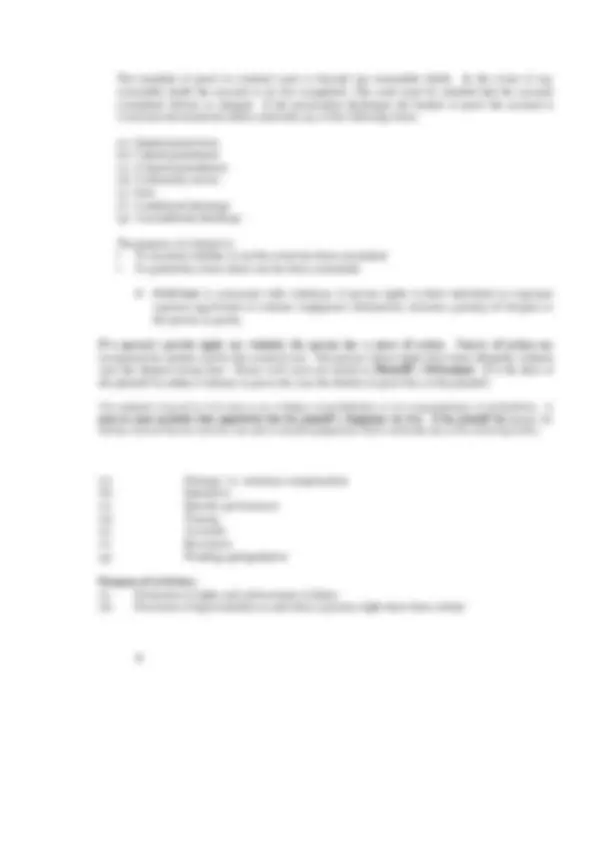



Study with the several resources on Docsity

Earn points by helping other students or get them with a premium plan


Prepare for your exams
Study with the several resources on Docsity

Earn points to download
Earn points by helping other students or get them with a premium plan
Community
Ask the community for help and clear up your study doubts
Discover the best universities in your country according to Docsity users
Free resources
Download our free guides on studying techniques, anxiety management strategies, and thesis advice from Docsity tutors
A comprehensive introduction to the fundamental concepts of law, exploring its definition, sources, purposes, and classification. It delves into various legal systems, including written and unwritten law, national and international law, public and private law, substantive and procedural law, and criminal and civil law. The document also examines the administration of justice, highlighting the roles of courts and the principles of proof in legal proceedings.
Typology: Lecture notes
1 / 3

This page cannot be seen from the preview
Don't miss anything!


Lesson 1. Definition of Law. Lesson 2. Sources of Law and the Administration of the Law.
1. DEFINITION OF LAW. Hart defines Law as a coercive instrument for regulating social behaviour. Law has also been defined as a command backed by sanctions. These two explanations of the term law presuppose the existence of a sovereign, which prescribes or formulates the commands and enforces sanctions, which is not necessarily the case. Salmond defines law consists of a body of principles recognised and applied by the state in the administration of justice. Law has also been defined as a collection of binding rules of human conduct prescribed by human beings for obedience of human beings. Inevitably, therefore law implies rules or principles enforced by courts of law. Rules of law are binding hence differ from other rules or regulations. Rules of law are certain. In summary therefore, law is an aggregate of conglomeration of rules enforced by courts of law at a given time. 2. SOURCES OF LAW AND THE ADMINISTRATION OF THE LAW. 1) Acts of parliament-These are enforceable 2) Customary and religious practises of the people-These are significant proportion of morality incorporated in law, they are enforceable to the extent of their incorporation into law. 3) Borrowed from other countries.
i) Rules of law facilitate administration of justice. It is an instrument used by human beings to achieve justice. (ii) Law assists in the maintenance of peace and order. Law promotes peaceful co-existence, that is, prevents anarchy. (iii) Law promotes good governance. (iv) Law is a standard setting and control mechanism. (v) Provision of legal remedies, protection of rights and duties. CLASSIFICATION OF LAW
1) Written Law and Unwritten Law: Written Law These are rules of law that have been reduced into a written form. They are embodied in a formal document for example The Constitution, laws made by parliament (statutes). Such laws prevail over unwritten Law. Unwritten Law These are rules of law that have not been reduced into written form. They are not embodied in any single document for example African Customary Law, Islamic Law, Hindu Law, Common Law, Equity. Their existence must be proved. 2) National and International Law: National or Municipal Law are rules of law operational within the boundaries of a country. It regulates the relation between citizens and between citizens and the state. It is based on Acts of Parliament, customary and religious practices of the people. International Law It is a body of rules that regulates relations between countries/states and other international persons egg United Nations. It is based on international agreements of treaties and customary practices of states and general principles. 3) Public Law and Private law: Public law consists of those fields or branches of law in which the state has an interest as the sovereign egg criminal law, constitutional law, administrative law. Public law is concerned with the constitution and functions of the various organs of government including local authorities, their relations with each other and with the citizens. Public law asserts state sovereignty/power. Private law is concerned with day-to-day transactions of legal relationships between persons. It defines the rights and duties of parties. 4) Substantive Law and Procedural Law: Substantive Law is concerned with the rules themselves as opposed to the procedure on how to apply them. It defines the rights and duties of parties and provides remedies when those rights are violated e.g. law of contract, negligence, defamation. It defines offences and prescribes punishment e.g. Penal Code Cap 63. Procedural Law describe the steps or guiding principles or rules of practice to be complied with or followed in the administration of justice or in the application of substantive law. It is also referred to as adjective law e.g. Criminal Procedure code Cap 75, civil procedure Act Cap 21. 5) Criminal Law and Civil Law Criminal law has been defined as the law of crimes. A crime has been defined as an act or omission, committed or omitted in violation of public law egg murder, manslaughter, robbery, burglary, rape, stealing, theft by servant or agent. All crimes or offences in are created by parliament through statutes. Suspects are arrested by the state through the police. However, individuals have the liberty to arrest suspects. Offences are generally prosecuted by the state. When charged with a particular offence the suspect becomes an accused hence criminal cases are styled as R V Accused. Under sec 77 of the constitution the person cannot generally be prosecuted for an act or omission which was not defined by law as a crime when committed or omitted. Under section 77 (2) (a) of the constitution an accused person is presumed innocent until proven or has pleaded guilty. It is the duty of the prosecution to prove its case against the accused. The burden of proof rests on the prosecution.